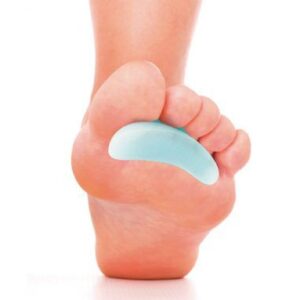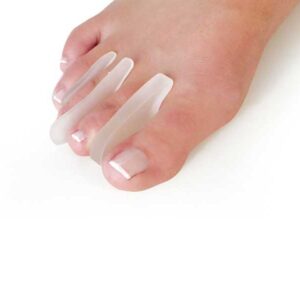Bunion / Hallux Valgus
Hallux valgus, popularly known as a bunion, is a deformity that involves the hallux (big toe) tilting towards the other toes, forming a bony protuberance in the joint at the base of the toe.
Most common foot pathologies
Symptoms
Bony protuberance in the joint at the base of the toe; Pain and inflammation especially when wearing tight shoes; Deviation of the toe towards the other toes; Calluses can form due to abnormal pressure on the contact points.
Risk Factors
Women are more likely to develop bunions than men; inappropriate footwear such as tight, high-heeled or pointed shoes; advanced age; predisposing anatomical conditions such as flat feet or metatarsal deviation or other structural misalignments of the foot bones; genetic predisposition to deformity.
Protective Factors
Wearing suitable footwear such as wide shoes with a wide toe and low heels; orthopaedic accessories such as cushions and devices to correct the posture of the foot; strengthening exercises for the muscles around the joint.
Treatment
Adjustments to footwear by choosing comfortable and appropriate shoes; Orthopaedic accessories such as cushions and protectors to relieve pressure; Exercises to strengthen muscles and improve mobility; Surgery may be indicated in severe cases or when other methods are not effective.
Information: All the information contained here is merely a summary for a general understanding of the pathologies, highlighting their definition, symptoms, risk factors, protective measures and treatment options.
Consulting a specialised health professional is essential for an accurate diagnosis and an effective treatment plan.
Support and protection for bunions / Hallux Valgus
Discover all the orthotics for bunions / Hallux Valgus
-
Seleccione Opções This product has multiple variants. The options may be chosen on the product page
-
Seleccione Opções This product has multiple variants. The options may be chosen on the product page
-
Seleccione Opções This product has multiple variants. The options may be chosen on the product page
-
Seleccione Opções This product has multiple variants. The options may be chosen on the product page
-
Seleccione Opções This product has multiple variants. The options may be chosen on the product page
-
Seleccione Opções This product has multiple variants. The options may be chosen on the product page
-
Seleccione Opções This product has multiple variants. The options may be chosen on the product page
-
Seleccione Opções This product has multiple variants. The options may be chosen on the product page
-
Seleccione Opções This product has multiple variants. The options may be chosen on the product page
-
Seleccione Opções This product has multiple variants. The options may be chosen on the product page
-
Seleccione Opções This product has multiple variants. The options may be chosen on the product page
-
Seleccione Opções This product has multiple variants. The options may be chosen on the product page
-
Seleccione Opções This product has multiple variants. The options may be chosen on the product page
-
Seleccione Opções This product has multiple variants. The options may be chosen on the product page
-
Seleccione Opções This product has multiple variants. The options may be chosen on the product page
-
Seleccione Opções This product has multiple variants. The options may be chosen on the product page
-
Seleccione Opções This product has multiple variants. The options may be chosen on the product page






























